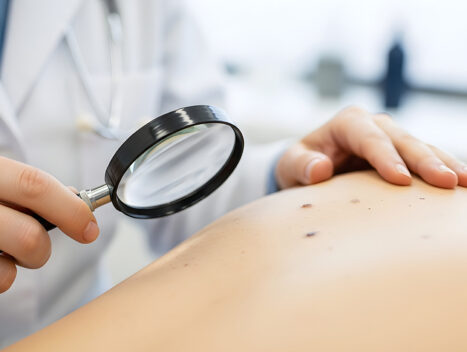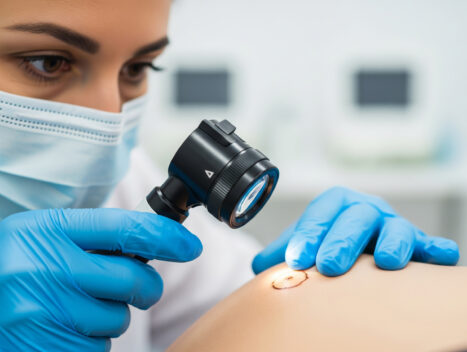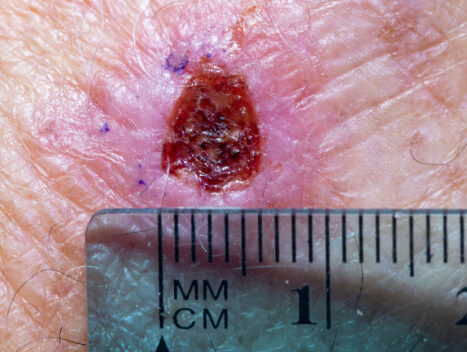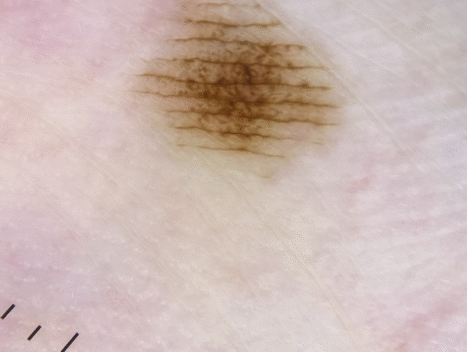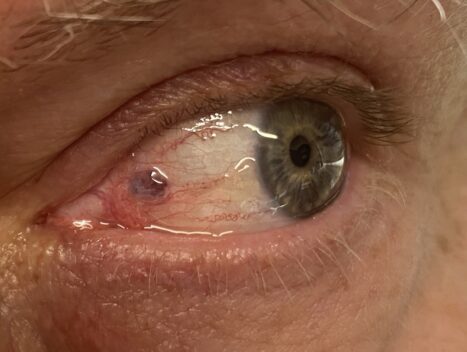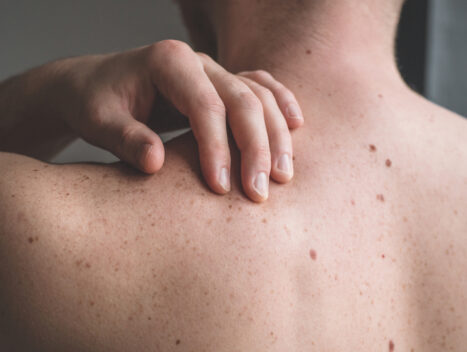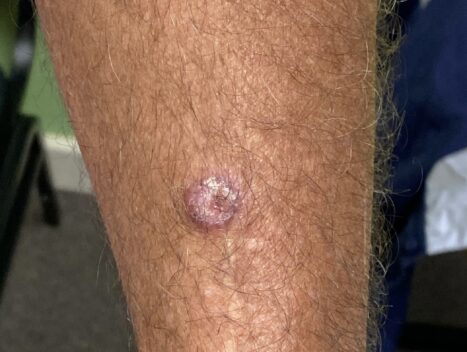Asked Questions
Who should have a skin cancer check?
Anyone who is higher risk for skin cancer: people with fair skin, freckles, red or blond hair people with frequent sun exposure – outdoor jobs or sports/hobbies those with a family history of skin cancer patients who have had a past skin cancer patients on immune modulating medications / transplant patients those with multiple moles/freckles anyone who is worried about skin cancer or who has a changing or new mole/spot
At what age should you first have a skin check?
There is no particular age that is recommended to start skin cancer checks. We recommend persons in thier early 20’s if they are interested, they come in for a once off check and education about skin cancer and its prevention. Very rarely a skin cancer can occur in children, so if a spot is very odd or rapidly changing even children should come in for a check.
What is involved in a full body skin check?
During your skin cancer check, you will not be removing all your clothes, you will leave your underwear on. Make sure you attend with no makeup, nail polish removed and make note of any spots you would like to discuss. During your skin check your clinician will systematically look at your skin part by part, inspecting any lesions of concern with a dermatoscope (a special skin microscope). Sometimes photos of particular lesions will be taken and uploaded into your clinical file. If anything suspicious is found on your skin, we will take a photograph and refer you for diagnosis, management and or treatment.
What changes should I watch for in a skin spot, bump, or blemish?
“Change” itself is a serious symptom to watch for, particularly something growing/thickening and changing over several weeks or months. It is also good to keep the “ABCDE’s” of skin cancer detection in mind. A= asymmetry B = border (irregular or non distinct) C = colour – more than one colour, changing colour, different colour to other lesions D = diameter (enlarging diameter, or diameter > 6mm) E = evolution (or as above “CHANGE”!)
Can skin cancer affect areas of skin that are not exposed to the sun?
Yes it can! It is much more likely to affect sun damaged areas or as we like to call them “high impact sites” The most common places are the areas of the body that are most often exposed to the sun, such as face, ears, forearms and back of hands. But anywhere you have skin it is possible to get skin cancer, that is why we suggest you pay attention to your own skin – Know your skin and know your moles.
What is the best prevention for skin cancer?
Slip (on a shirt), slop (on sunscreen), slap (on a hat), slide (on sunglasses) and seek (shade). Have a regular yearly skin cancer check to detect lesions at an early treatable stage.
What should I be looking for on my own skin?
We want you to know your skin, most skin cancers will grow as a new spot or blotch on your skin. We also want you to know your moles, that’s so you know if they’re growing or changing. You should pay attention to anything new growing on your skin. Pink crusty, scaley, ulcerated, grows or bleeds over a short time frame should be checked regardless if it is dark or pink. If you notice any new or changing moles or skin lesions that do not resolve in 4-6 weeks we strongly suggest to book an appointment as soon as possible. Some changes to look out for: New skin lesions Change in colour Becomes raised or lumpy Increases in size Bleeds or weeps Becomes rough or scaly Becomes itchy or sore Looks different to your other moles and lesions Skin cancer can be a range of shapes, sizes, and colour. If in doubt, let us check it out!
What is the difference between chemical sunscreen and zinc cream?
Sunscreen uses ingredients to absorb and reflect UV rays. Zinc uses the same ingredients to absorb and reflect UV rays. We recommend just finding a product you like, that feels good on your skin and something that you’re happy to wear each day. The application and then the reapplication are important factors to preventing sunburn and skin cancer.
How much sun do we need for Vitamin D?
few minutes of sunlight exposure outside peak UV periods on most days of the week can be sufficient for most people to maintain healthy vitamin D levels, depending on skin type and geographical location
Is chopping the lesion out (excision) the only way to treat skin cancer?
Excision is a common way to treat skin cancer. Sometimes there are other options depending on the type of cancer or pre-cancerous lesion and the location. Treatment options may include freezing with liquid nitrogen, PDT (photo dynamic therapy), Laser, immune modulating creams such as Aldara, Effudex or radiotherapy. Your Doctor will discuss the best treatment options for your individual circumstances.
What are the main types of skin cancer?
Skin cancer results from abnormal growth of skin cells, most often due to UV radiation exposure. The most common types of skin cancers are basal cell carcinoma (BCC), squamous cell carcinoma (SCC), and melanoma, with varying degrees of severity.
Is it only necessary to wear sunscreen on hot, sunny days?
UV radiation, which causes sunburn and skin damage, can be high even on cool or cloudy days, so protection is necessary whenever the UV index is 3 or above. Outdoor workers should apply sunscreen every day regardless of UV index
What is the SunSmart app?
This is a great free app that you can download from the app store or via the SunSmart app website. It will give you information about the UV rating each day – calculated from local weather reports, and apply this to your skin type/age to advise you when you need to use sun protection for the day. https://www.sunsmart.com.au/
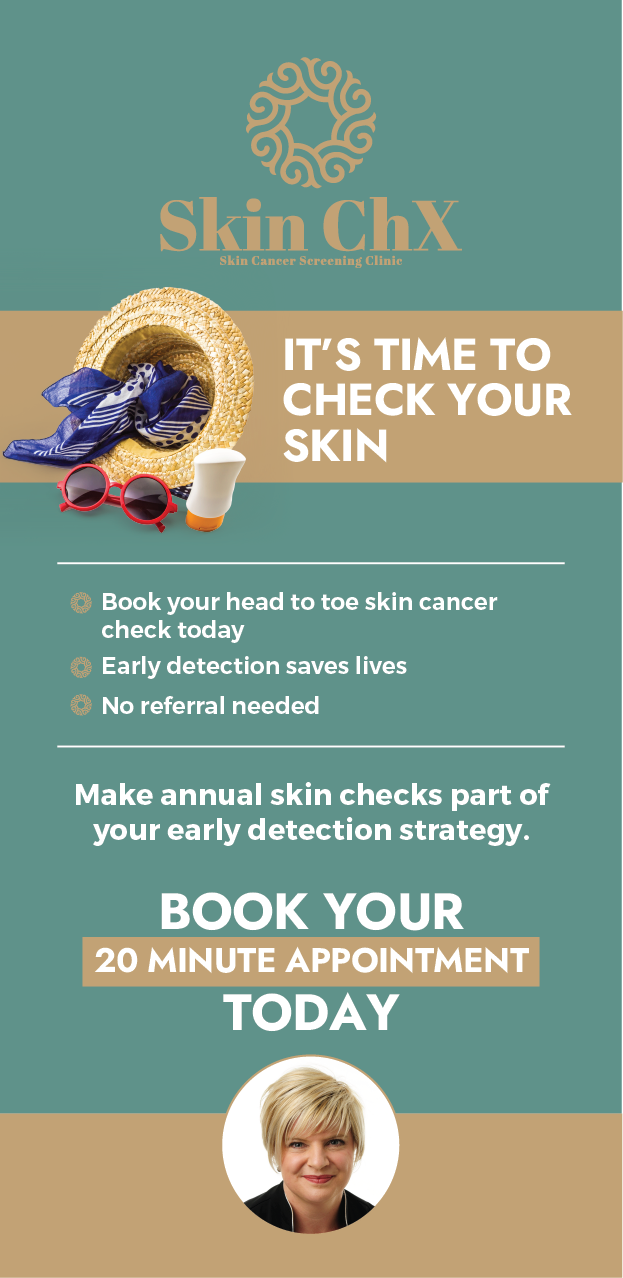
See Our Latest Blog
- Chris Comans
- 0 Comments
Summer in WA: Why Your Skin Cancer Risk Rises – And How Skin ChX Helps Protect You
With summer fast approaching in Western Australia, it’s important to remember that evenTen minutes of unprotected sun exposure can damage your skin. Sunburn, premature ageing, and potentially deadly skin cancers are all consequences of UV radiation, something our state experiences at some of the highest levels in the world. But contrary to popular belief, your […]
- Chris Comans
- 0 Comments
Why Advanced Onsite Skin Cancer Screening Matters: How Skin ChX Is Protecting WA Workplaces
In Western Australia, sun exposure is a part of everyday life. Whether you’re workingoutdoors, driving between sites, or simply living under WA’s relentless UV, the risk ofdeveloping skin cancer is significantly higher than in most parts of the world. For many workplaces, particularly those across the Pilbara, Goldfields, Wheatbelt and the South West, this risk […]
- Chris Comans
- 0 Comments
Protecting WA: How Skin ChX Community Skin Cancer Screening & Education Programs Are Saving Lives Across the State
Western Australia has one of the highest rates of skin cancer in the world. Our climate, outdoor lifestyle, and long hours of sun exposure mean that every West Aussie from coastal communities to inland mining towns face a lifelong risk of developing skin cancer. Yet many people still go without regular skin checks due to […]
- Chris Comans
- 0 Comments
Viruses, Immunity and the Skin: When the Body’s Defences Falter
Most Australians associate skin cancer with the summer sun — and with good reason. Yet beneath that familiar story lies another: cancers that form not from UV damage, but from changes in immunity and viral infection. Our skin isn’t just a barrier; it’s an immune organ. Every day, immune cells patrol its surface, repairing damage and […]
- Chris Comans
- 0 Comments
Toxins, Scars and Syndromes: The Hidden Triggers of Skin Cancer
When we think about skin cancer, the image that usually comes to mind is someone who’s spent years in the harsh Australian sun. But not every case fits that story. Some skin cancers develop because of toxic exposures, chronic injury, or inherited conditions that quietly change the way our skin behaves. These causes are rare, […]
- Chris Comans
- 0 Comments
When It’s Not the Sun: Understanding Non-UV Skin Cancers
We all know the message: slip, slop, slap, seek, and slide. Sun safety has been the cornerstone of Australian skin-cancer prevention for decades. And rightly so — the majority of skin cancers we see in clinics are directly linked to ultraviolet (UV) radiation. But what’s less understood is that not every skin cancer starts with […]
- Chris Comans
- 1 Comment
Diagnostic Algorithms for Melanoma on the Palms: A Dermoscopy Perspective
Melanoma of the palms, also referred to as acral melanoma, is an uncommon but high-risk type of skin cancer. The unique skin structure and pigmentation patterns of the palms make diagnostic assessment more complex compared with other body sites. As a skin cancer screening practitioner, the use of structured diagnostic algorithms combined with distributive dermoscopy […]
- Chris Comans
- 0 Comments
Dermatoscopic Features of Eye Cancers: Why Screening Matters
The skin around the eyes is among the most delicate on the body. It is thin, highly exposed to ultraviolet (UV) radiation, and often neglected when applying sunscreen. Decades of sunbathing with eyes closed provided no real protection — ultraviolet rays penetrated the eyelids, causing long-term cellular damage. This explains why basal cell carcinoma (BCC), […]
- Chris Comans
- 0 Comments
Skin Cancer on the Back: Early Detection with Structured Dermoscopic Assessment
Skin cancers that develop on the back can pose a serious challenge for early detection. Unlike the face, arms, or legs, the back is difficult for individuals to observe regularly, which means lesions may go unnoticed until they become advanced. For skin cancer screening practitioners, applying a systematic method of dermoscopic assessment—beginning with recognition of […]
- Chris Comans
- 1 Comment
Skin Cancer on the Arms: A Common Site of Sun Damage in Western Australia
When it comes to skin cancer, the arms are one of the most frequently affected areas I see in screenings. They are constantly exposed to the sun during our daily activities, yet many people don’t realise just how vulnerable this part of the body is. In Western Australia, where we live with some of the […]
